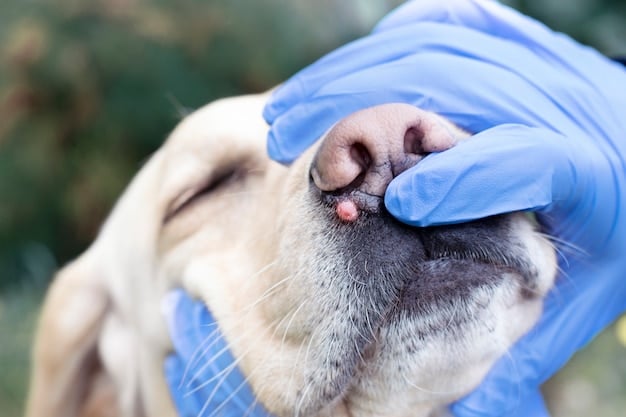
Say Goodbye to Dog Allergy Solutions
Dog allergies are caused by a reaction to proteins found in a dog’s skin cells, saliva, or urine. When a person with allergies comes into contact with these proteins, their immune system overreacts, triggering symptoms such as sneezing, itching, and watery eyes. Pet dander, tiny flecks of skin shed by animals, is a common allergen. In some cases, people may also be allergic to the proteins found in a dog’s saliva or urine.

Dog Allergy Solutions
In this article, you will learn: – The causes and triggers of dog allergies, common symptoms, and the significance of managing them effectively. – Characteristics of hypoallergenic dog breeds, popular choices, and tips for choosing the right one. – Techniques for reducing allergens at home, natural remedies, medical treatments, and expert advice for coexisting comfortably with dogs.
Common Symptoms of Dog Allergies: Identifying the Signs
Dog allergies can manifest through various symptoms, including sneezing, runny or stuffy nose, coughing, wheezing, chest tightness, and shortness of breath. Skin symptoms such as red, itchy skin or hives can also occur upon contact with dogs. Additionally, allergic individuals may experience watery, red, or itchy eyes, and in severe cases, asthma symptoms may be triggered.
Importance of Finding Effective Solutions: Managing Dog Allergies
Living with dog allergies can significantly impact an individual’s quality of life. It can lead to chronic discomfort and exacerbate existing respiratory conditions such as asthma. Moreover, the emotional distress of having to avoid or limit interactions with dogs can be challenging. Therefore, finding effective solutions to manage dog allergies is crucial for overall well-being.
Hypoallergenic Dog Breeds
Hypoallergenic dog breeds are those that produce fewer allergens, making them suitable for some allergy sufferers. These breeds are known to shed less dander and produce lower amounts of saliva and urine proteins, reducing the likelihood of triggering allergic reactions.
Characteristics of Hypoallergenic Dog Breeds
Hypoallergenic dog breeds typically have hair instead of fur, which reduces the shedding of dander. Additionally, they tend to produce less saliva, minimizing the spread of allergens through licking and drooling. These breeds often have a single-layered coat, which further decreases the dispersal of dander.

Popular Hypoallergenic Dog Breeds
Some popular hypoallergenic dog breeds include the Poodle, Bichon Frise, Maltese, Shih Tzu, and Portuguese Water Dog. These breeds are known for their minimal shedding and reduced production of allergens, making them suitable companions for individuals with dog allergies.
Tips for Choosing a Hypoallergenic Dog
When selecting a hypoallergenic dog, it’s essential to consider factors such as the dog’s size, energy level, and temperament to ensure compatibility with the individual’s lifestyle and living situation. Additionally, spending time with the chosen breed before making a commitment can help assess the individual’s allergic response to the specific dog.
Reducing Allergens in the Home
Reducing allergens in the home is crucial for creating a comfortable environment for individuals with dog allergies. Various practices and strategies can help minimize the presence of allergens, thereby alleviating allergic reactions.
Regular Grooming Practices for Dogs
Regular grooming practices, such as frequent baths using hypoallergenic shampoos, brushing to remove loose hair and dander, and keeping the dog’s coat trimmed, can significantly reduce the amount of allergens present on the dog’s skin and fur.
Cleaning Tips to Minimize Allergens
To minimize allergens in the home, it’s important to vacuum carpets, rugs, and upholstery regularly using a high-efficiency particulate air (HEPA) filter vacuum. Washing the dog’s bedding and other washable items in hot water can help eliminate allergens. Additionally, using allergen-proof covers for pillows and mattresses can reduce exposure to pet dander.

Air Purifiers and Other Home Solutions
Using HEPA air purifiers in the home can help capture and remove airborne allergens, including pet dander. Keeping the home well-ventilated and using a dehumidifier to maintain optimal humidity levels can also contribute to reducing allergens. Furthermore, minimizing the dog’s access to certain areas of the home, such as bedrooms, can help limit exposure to allergens.
Natural Remedies and Medical Treatments
Managing dog allergies involves exploring various natural remedies and medical treatments to alleviate symptoms and improve quality of life for individuals affected by dog allergies.
Natural Remedies for Managing Dog Allergies
Natural remedies such as regularly bathing and grooming the dog, using saline nasal rinses, and incorporating omega-3 fatty acids into the diet can help alleviate allergy symptoms. Additionally, maintaining a clean living environment and using natural cleaning products can contribute to reducing allergen exposure.
Medical Treatments and Interventions
For individuals with dog allergies, medical treatments such as over-the-counter or prescription antihistamines, nasal corticosteroids, and decongestants can provide relief from allergy symptoms. Allergen immunotherapy, commonly known as allergy shots, may also be recommended to desensitize the immune system to specific allergens, including dog dander.
Consultation with Allergists and Veterinarians
Seeking guidance from allergists and veterinarians is crucial for developing a comprehensive management plan for dog allergies. Allergists can conduct allergy testing to identify specific triggers and recommend suitable treatment options, while veterinarians can provide advice on grooming practices and pet care to minimize allergen exposure.
Coexisting Comfortably with Dogs
Coexisting comfortably with dogs despite having allergies is achievable with lifestyle adjustments, the use of specific products designed for allergy management, and seeking expert insights on managing dog allergies effectively.

Lifestyle Adjustments for Coexisting with Dogs
Making lifestyle adjustments such as creating pet-free zones in the home, washing hands and changing clothes after interacting with dogs, and using a high-efficiency furnace filter can help reduce allergen exposure. Moreover, implementing a regular cleaning schedule and considering non-fabric furniture can further minimize allergens in the home.
Product Recommendations for Dog Allergy Management
Using allergy-friendly cleaning products, such as hypoallergenic surface cleaners and laundry detergents, can help reduce allergens in the home. Additionally, investing in allergen-proof bedding and air purifiers specifically designed to capture pet dander can contribute to managing dog allergies effectively.
Expert Insights for Individuals with Dog Allergies
Seeking advice from allergists, veterinarians, and experienced pet owners can provide valuable insights and practical tips for navigating life with dog allergies. These experts can offer guidance on grooming best practices, selecting suitable hypoallergenic dog breeds, and creating an allergen-minimized living space.
Conclusion
In conclusion, managing dog allergies is essential for individuals who desire to coexist comfortably with dogs. Understanding the causes and triggers of dog allergies, identifying common symptoms, and exploring effective solutions, including hypoallergenic dog breeds, allergen reduction strategies, natural remedies, and medical treatments, are crucial steps in achieving a balanced and allergy-managed lifestyle. By implementing lifestyle adjustments, utilizing specific products, and seeking expert insights, individuals with dog allergies can create a conducive environment for coexisting with dogs while minimizing allergic reactions.
FAQs
Personal Story: Overcoming Allergies to Embrace Dog Ownership
Finding the Perfect Hypoallergenic Companion
My name is Sarah, and I used to suffer from severe allergies to dogs. I always dreamed of having a furry companion, but my allergies made it seem impossible. After doing some research, I discovered the world of hypoallergenic dog breeds. I was thrilled to learn that certain breeds produce fewer allergens, making it possible for allergy sufferers like me to finally have a dog.
I decided to welcome a Bichon Frise into my home, a breed known for being hypoallergenic. This decision has truly changed my life. I no longer have to worry about constant sneezing and itchy eyes, and I can enjoy the companionship of a loving pet without compromising my health.
This personal experience has shown me that with the right knowledge and resources, individuals with dog allergies can find the perfect hypoallergenic companion to coexist comfortably with dogs.
Q1: Can dog allergies develop over time, or are they present from birth?
Yes, dog allergies can develop at any age, even in individuals who have never shown signs of allergies before. Exposure to dogs over time can lead to the development of allergic reactions.
Q2: Are there specific dog breeds that are completely hypoallergenic?
While no dog breed is completely hypoallergenic, certain breeds are known to produce fewer allergens, making them more suitable for individuals with allergies.
Q3: Can regular grooming practices eliminate dog allergens completely?
Regular grooming practices, such as bathing and brushing, can significantly reduce the presence of allergens on a dog’s skin and fur, but they may not eliminate allergens entirely.
Q4: Is it possible for individuals with severe dog allergies to build tolerance over time?
In some cases, individuals with dog allergies may develop some level of tolerance after prolonged exposure to specific dogs. However, this is not guaranteed, and it varies from person to person.
Q5: Are there any specific dietary changes that can help manage dog allergies?
Incorporating omega-3 fatty acids into the diet may help alleviate allergy symptoms for some individuals. However, dietary changes should be discussed with a healthcare professional to ensure suitability and effectiveness.
Facebook
Pinterest
Twitter
LinkedIn

